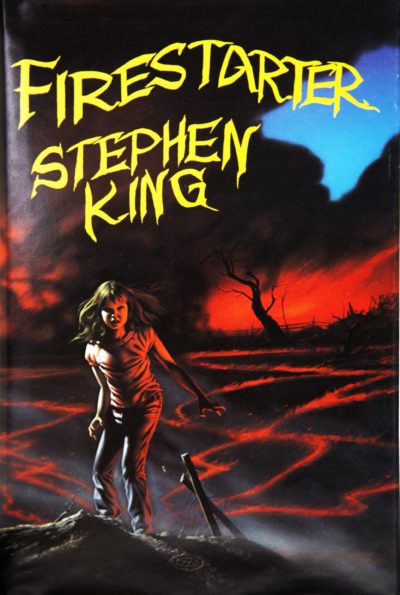Literary rating: ★★★½
Kick-butt quotient: ☆☆
 Having watched both versions of the film, I followed up by reading the book on which they were based. Despite my general fondness for horror, I haven’t read very much Stephen King: this is only the second novel of his, after Salem’s Lot. First thought: at 576 pages in the mass paperback edition, it’s quite a door-stopper, and you can see the problems in adapting a work of that size into a movie. Inevitably, a lot of the detail and nuance is going to be excised. There’s no doubt, the 1984 version is more faithful; the 2022 adaptation takes the basic concept of a young girl with pyrokinetic powers, on the run from the government with her father, and does its own thing, more or less.
Having watched both versions of the film, I followed up by reading the book on which they were based. Despite my general fondness for horror, I haven’t read very much Stephen King: this is only the second novel of his, after Salem’s Lot. First thought: at 576 pages in the mass paperback edition, it’s quite a door-stopper, and you can see the problems in adapting a work of that size into a movie. Inevitably, a lot of the detail and nuance is going to be excised. There’s no doubt, the 1984 version is more faithful; the 2022 adaptation takes the basic concept of a young girl with pyrokinetic powers, on the run from the government with her father, and does its own thing, more or less.
How you feel about those different approaches, probably depends on how you feel about the original book. Despite the length, it wasn’t a chore; I was typically reading 25-30 minutes a night, and never felt like it was a burden. King had a relatively straightforward style, that’s generally easy to read. The novel does, like the 1984 film, move back and forth in the time-line. It begins with Charlie and her dad trying to escape the experimental government program which spawned them, only later filling in how they got to this point – both the events of that program, and the subsequent surveillance, leading to the death of her mother. This, to me, worked better on the page than the screen, where it ended up becoming too convoluted.
You get a good deal more background on “The Shop”, the murky federal group behind everything, and its employees. In particular, a good portion is told from the perspective of near-insane operative, John Rainbird, Here, he’s very badly disfigured, the result of a friendly-fire incident in the Vietnam War, which seems to have helped push him over the edge. His madness is considerably more apparent in the book, along with the dubious nature of his psychological attachment to – almost dependence on – Charlie. The novel also delves deeper into Charlies’ internal struggle for self-control, fighting to keep hold of her talent, rather than letting it rule her.
While both film versions end with her fiery escape from the shop, albeit in radically different ways, the book has a fairly lengthy coda. [spoilers follow]. This covers Charlie’s return to the Manders farm, where she finds sanctuary once more. Inevitably, however, word seeps out and the Shop pay a visit, only to find their target already left. The novel finishes with Charlie arriving at the offices of Rolling Stone magazine, ready to tell her story. From a 2022 viewpoint, this had not aged well, with that publication now a de facto mouthpiece for the establishment, with as much counter-culture credibility as Teen Vogue or Buzzfeed. However, this remains an entertaining read, and if such a talent ever existed, you sense the events it depicts are quite plausibly how things could go down. Here’s hoping we never find out.
Author: Stephen King
Publisher: Pocket Books, available through Amazon, both as a paperback and an e-book
Standalone novel.




